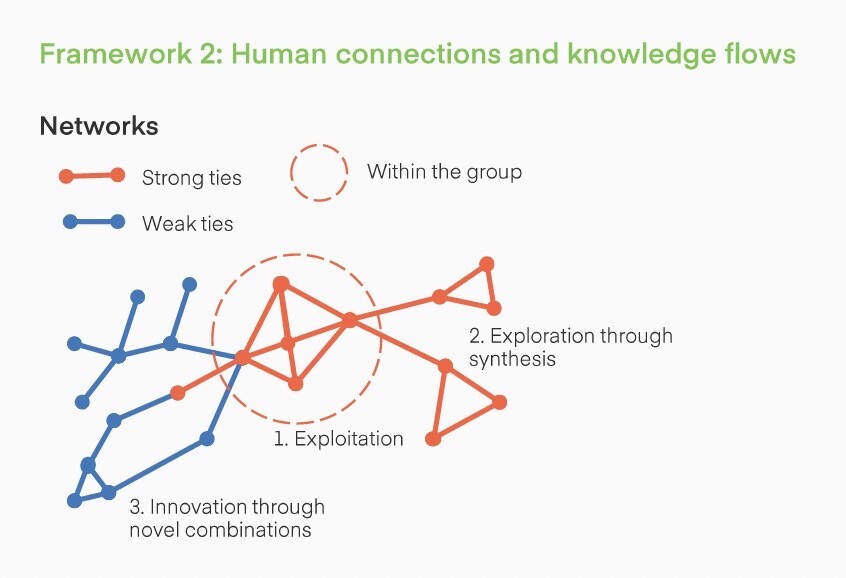
One of the highest risks when your people work from home is that the communication with their colleagues will be reduced, thus obstructing the knowledge flow, hindering cooperation and “suffocating” the creative innovation in your team.
There are two types of knowledge:
Explicit and Tacit Knowledge
You can document the Explicit knowledge. These are the practices and processes in your company. In fact companies that scale successfully working remotely invest in documenting this knowledge. This is their key asset.
Send me a link!
Every time someone asks you “How to?” question, instead of writing an email or calling the person you “send a link”. There is already a knowledge document with embedded screenshots and videos explaining how this is done. If not, you create the document, record the video and then “send a link”
Tacit Knowledge
The tacit knowledge is hard to document. It is when you need advice but are not sure who to contact, or not comfortable enough to contact him or her. This can also be a new insight born just “bumping” into someone near the watercooler. This kind of “tacit knowledge exchange” suffers most during extensive home office working (in different places) or extensive a-synchronous working (at different times).
Strong and Weak ties
In order to explore how the knowledge flows in your organization, particularly the tacit knowledge, let me introduce the concept of people networks and strong and weak ties. Strong ties are with people you know well and trust. They could be part of your team or project but also can be part of other departments or organizations. You usually ask for advice your strong ties. You could also call a meeting or create a forum in order to build on each other’s knowledge and ideas.
 Lynda Gratton’s book “Redesigning work”.
Lynda Gratton’s book “Redesigning work”.Weak ties are with people you don’t know so well but you know they possess particular knowledge. The weak ties are significantly impacted by the ever-growing remote and a-synchronous working where you tend to speak more to the people you know well. Therefore you need to create and simulate this “bumping” into each other moments , these “serendipity encounters”.
3 Tips
Let me give you three tips on how to manage both the explicit and tacit knowledge in order to ensure that it flows smoothly and Innovation thrives in your organization.
Tip 1. Establish robust platform and process for documenting your explicit knowledge
Invest in documenting explicit knowledge. Make sure people document all knowledge they possess or develop in the course of work. I work with many fully remote companies that scale without having an office. It is a key requirement on a regular basis to document your knowledge. Every time you create or optimize a process, you document the knowledge in the most visual and engaging way, using videos and screenshots. Importantly you post it in a knowledge management system where people can ask questions, comment and have a discussion on the topic, For this you need a system – not necessarily an expensive one, could be an MS Team room, but it has to be searchable by topic and by expert.
Tip 2. Create an environment to ensure your tacit knowledge flows
How to enable the weak ties and stimulate the “serendipity encounters” How to create an environment where people exchange knowledge on an informal basis? In this case technology can help a lot.
Let me give you an example from Pricewaterhousecoopers (PWC). This is a company which recruits tens of thousands freshly graduated students into their consulting business. Before the COVID19 pandemic they used to have a big conference with all the new recruits. There the new joiners can hear from the senior management what is the vision and organisational goals, and “how we work here”. When the lockdown happened this conference was no longer possible.
Regardless which industry you are in, the proper induction of new employees is key. It aims to get them up to speed and productive by enabling the knowledge flow, learning and mentoring by experienced colleagues.
For this Pricewaterhousecoopers created a virtual reality (VR) platform i.e. a virtual venue where people can “bump” into each other. There was some matchmaking taking place who do you “bump into” but also randomly or by your choice. When you enter the platform with your VR set you meet new colleagues and exchange ideas.
You could also attend presentations by the Senior Management of PWC. In these easy to navigate VR rooms you could listen and see the “big picture” from the “horse’s mouth”.
You could even go on a Virtual Speedboat trip.
 VR Speedboat tirp for the new recruits
VR Speedboat tirp for the new recruitsVR allows for exciting experiences so this is one ways to stimulate this environment.
Never underestimate the informal flows of tacit knowledge.
For example – research shows that when people searching for a job they rarely hear it from somebody in their very close circle of friends. Usually they hear it from someone they know but not part of this circle.
Regardless which industry you are in, you need to explore how knowledge flows in your organization. Based on that it is critical to enable and ensure that both explicit and tacit knowledge flows and fosters cooperation and innovation.
Tip 3. Establish a network of Knowledge Champions
I’m a big fan of people-centric organizations and strengths oriented management.
And in my method “Virtual Power Teams” we discover the natural strengths and talents of each team member in a short but effective peer coaching. Those with deep expertise in a particular area become the Knowledge champions. They drive forward this Knowledge area in the searchable knowledge database (Tip 1). They post new articles in their area of expertise, facilitate discussions and overall foster the knowledge flow and ensure its properly documented.
As this is their “strength” area they do not consider it an extra “work. It is enjoyable for them and enables the natural flow of knowledge in your team and organization.
So those are the three tips
- Establish robust platform for documenting your explicit knowledge
- Create an environment to ensure your tacit knowledge flows
- Establish a network of knowledge champions to drive the knowledge sharing and flow
Let me wish you inspiration and success in enabling the knowledge flow, cooperation and creative innovation in your organization!
What is your Question or Insight on Knowledge Management in virtual or hybrid tips?





